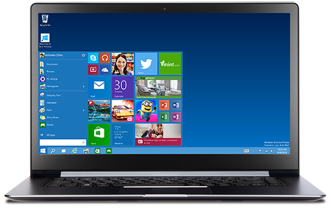

Jim's Windows 10 Technical Preview Review
(Updated: Monday, October 13, 2014)
The Windows 10 Technical Preview release (intended for beta-testing) was made available Oct 1, 2014. On October 13, 2014, I gave this presentation on Windows 10 to the Computer Club of the Sandhills. I have previously presented sessions on Windows 8 Developer Preview, Consumer Preview, and Windows 8.1. Windows 8 was released officially on October 26, 2012. The update to Windows 8, named 8.1, was publicly available on Oct. 17, 2013. The Windows 10 final product is expected to be available sometime in mid-2015.
Windows 10 is expected to be much like a combination of Windows 7 and Windows 8.x with new user-friendly features and customizability. MS hopes that it will appeal to desktop users who currently prefer Windows 7 (and even more to all those XP holdouts). As you are no doubt aware MS no longer provides support for or updates to Windows XP.
This Review/Preview presents Windows 10 Technical Preview by contrasting it with 8.x, and showing its major new features. For the features of the previous version, Windows 8/8.1, please see Jim's Windows 8.1 Review/Preview. I believe Windows 8/8.1 was somewhat unfairly criticized as being "junk," "stupid," "unusable," "fill-in-your-favorite-negative epithet," for one reason - the default to the so-called "Start Screen" on keyboard/mouse driven computers (and the associated "immersive" or full-screen Windows 8 specific apps) made it difficult to control the functions of the operating system with mouse and keyboard. It could be done, but doing so was definitely non-intuitive for the typical desktop user. Those criticisms could be largely overcome by installing a small free application called "Classic Shell" that brings back the start menu. The performance of Windows 8/8.1 was outstanding in my experience (using Vista-era hardware). I have found similar performance from Windows 10 even in this early release.
- Prologue:
- Why Windows 10 instead of Windows 9?
- My Experiences with Windows 10
- Start Menu vs Start Screen: Key/mouse computers default to Start Menu (or what most people call the Desktop), touch enabled computers default to Start Screen (the tiles)
- Start Menu is back: But not your old Windows 7 Start Menu. Windows 10's Start Menu contains two columns (like Windows 7) list of apps on left as previously, but now tiles occupy the right column. Tiles can be apps, web sites, documents, folders.
- Start Menu can be resized! New tiles can easily be added to, or subtracted from, and resized in the tiles part of the Start Menu. Tiles that have the capability of being "live" may be enlivened or not (right-mouse click on tile for available options).
- Shutdown button relocated from old location at bottom to top of Start Menu, beside user name.
- Modern (Windows 8 specific) apps run in a moveable/resizeable window.
- The Charms/Charms bar are history (but still in Start Screen mode running on touch-enabled devices). Introduced in Windows 8, they proved so "uncharming," i.e, distracting, they have disappeared in Windows 10.
- File Explorer (previously called Windows Explorer as opposed to Internet Explorer) has added a seemingly redundant "Home" icon as the default location when File Explorer opens. This Home location includes frequently used folders (or what MS assumes will be frequently used - Documents, Pictures, Music, Videos).
- Right-mouse click on the Start Menu for a Control Panel shortcut menu (as previously available in Windows 8.1).
Interface surprises:
Caveat: Interface (and other) elements in Tech Review version may be modified before retail release in mid-2015.
- Performance considerations:
- Easy to install: After answering the dialog box with options for language, keyboard, etc., all that need to done is the wireless login (if you are using a laptop) and username/password setup. You can upgrade from Windows 7 or 8.X easily and it will preserve your programs and data.
- Boots quickly, even on older hardware. Same is true of Windows 8/8.1.
- Reasonably snappy performance on legacy hardware: I tested Win 10 on laptops that came with XP and Vista installed. This demonstration is being done on a Vista-era Compaq laptop with 3 gig of RAM. A Dell XP-era laptop with 1 gig of RAM was very slow, as might be expected. But still Windows 10 installed and the XP-era machine is usable if you have enough patience.
- Stable and useable: After using Windows 10 for several hours (this web page was largely researched, written, and uploaded via FTP to the server using Win 10) it seems very stable, useable as it stands, although MS warns not to use this Technical Preview version for a production machine. There is a risk of crashes and loss of data, but I did not experience any crashes or other instability. I did experience one error when trying to change from Start Menu view to Start Screen view.
- Windows 10 Features (from InformationWeek.com)
- The Start Menu is back and more customizable than ever.
- PC users won't see the tiled UI unless they activate it, since their machines will boot to the desktop by default.
- Search from the taskbar
- Virtual desktops
- Floating Modern apps
- New snap modes
- Windows 10 Hardware Requirements
- 1 gigahertz (GHz) or faster 32-bit (x86) or 64-bit (x64) processor
- 1 gigabyte (GB) RAM (32-bit) or 2 GB RAM (64-bit)
- 16 GB available hard disk space (32-bit) or 20 GB (64-bit)
- DirectX 9 graphics device with WDDM 1.0 or higher driver
- Taking advantage of touch input requires a screen that supports multi-touch
- To run "Modern" Apps, you need a screen resolution of 1024 X 768 or greater"
The Windows 10 works on the same hardware that powers Windows Vista and Windows 7:
- YouTube Videos of Windows 10
- Windows 10 for Businesses Official MS video (40 minutes)
- Windows 10 Demo (Technical Preview) (10 minutes)
- Windows 10 Technical Preview Review (16 minutes)
- Detailed Windows 10 Tour in just 8 Minutes!
- Windows 10 Technical Preview | New Features & Overview (14 minutes)
- Windows 10 Preview (8 minutes)
- Reviews of Windows 10
- Windows 10 Wikipedia article
- Windows 10: Nine things you need to know
- Windows 10: 11 Big Changes
- A closer look at Windows 10
- Hands On: Windows 10
- Windows 10 Review
- Windows 10 Technical Preview deep-dive
- Frequently Asked Questions about Windows 10
- Before you install Windows 10 Technical Preview
- Where to get Windows 10 Technical Preview (Windows Insider Program)
- Hands-on with Windows 10: Installing the Windows Technical Preview
- Windows 10, How To Log On Automatically
This article is Windows 8 specific, but also works in Windows 10 (personally confirmed).